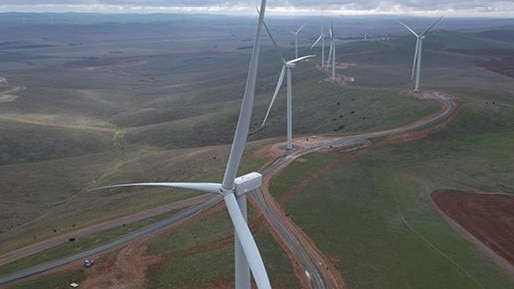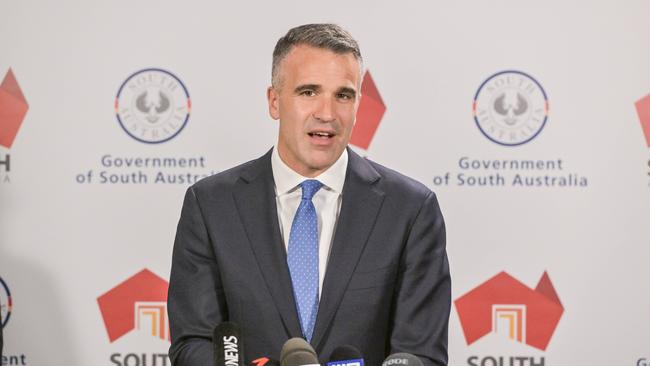SA power bills highest in nation as green energy struggles to make dent
SA’s world-beating green energy supply is not enough to drive down spiralling bills, according to a new report that says we have the priciest power in the land.
SA News
Don't miss out on the headlines from SA News. Followed categories will be added to My News.
South Australians are paying the highest electricity prices in the national grid, according to a top-level report warning cost relief might not come even with a clean energy supply surge.
A 136-page South Australian Productivity Commission inquiry into renewable energy says this has spurred a steady decline in electricity market spot prices since mid-2019, but this has “not flowed through to SA retail customers, who continue to face the highest electricity prices” across the National Electricity Market (NEM).
At least a doubling of wind and solar energy within a decade will be needed to meet state greenhouse gas reduction targets, the report finds, but this is unlikely to lead to reduced electricity prices because of the gap between wholesale and retail charges.
This is despite SA having a competitive advantage because of “several regions in which the combined solar and wind endowments are amongst the best in the world”.
The report blames the price gap on two limitations in the SA electricity system: a “market concentration in on-demand electricity”, or baseload generation, and a sometimes very low daytime demand for solar generation on sunny spring and summer days.

A gap between lower spot market prices and higher wholesale prices passed through to electricity consumers is explained by the cost of hedging, or offsetting financial risk, in the “illiquid and highly concentrated market for on-demand electricity”.
“As renewable energy continues to increase its market share in South Australia and continues to become cheaper to install, this will put downward pressure on prices,” the report says.
“Modelling undertaken for the Commission suggests that because of the factors in local markets pushing wholesale prices up above spot market prices … South Australian power prices are likely to remain higher than interstate.
“Unless this can be addressed, renewable energy will not generate competitive advantages for most electricity users”.
Other factors contributing to high retail electricity prices include substantially higher distribution and transmission costs because of a lower population density, a large geographic area to cover and lower industrial demand.
“South Australian costs are also higher due to a larger gap between average demand and peak demand in South Australia, compared to other regions in the NEM, which means that both the transmission and distribution infrastructure has to be large enough to handle significant peaks which occur only a few days per year,” the report says.
Current national grid regulations and pricing mechanisms are “not fit for purpose”, because they are “delivering neither lowest cost for consumers nor inducing sufficient investment in storage to support the renewable energy transition”.
Renewable energy installation is being frustrated by adverse state policy choices, including changes to planning rules which increased setbacks for wind farms and introduced them for solar farms.
This shrunk available land, because previously viable locations no longer had sufficient area for wind or solar farms. Emergency technical requirements to improve power system stability after the 2016 statewide blackout have added cost to renewable energy projects and should be reviewed, the report recommends, because the Australian Energy Market Operator has introduced stability measures.
Hydro plant clouded in doubt
Doubt hangs over the viability of a $593m state-owned hydrogen power plant – a centrepiece of the Malinauskas government’s economic plan – according to a state Productivity Commission report.
The proposed hydrogen plant at Whyalla, is labelled an opportunity to generate jobs and exports, but the report warns minimising risks, including construction costs, and ensuring electricity prices are lowered “will be critical to ensure it is a worthwhile investment”.
Green hydrogen, produced using renewable energy, is a highly competitive export sector, the report cautions – and South Australia now has the smallest number of projects of Australian states.
SA’s poor budgetary position and economic growth performance constraints state government support for developing green hydrogen, in the face of other states offering “substantial financial support to developers”.
“If a decision was made to pursue the opportunities in green hydrogen, it is likely that they would only be secured if the state gets everything right – a world-class plan, world-class people (management and delivery), with the right delegated authority to deliver the right projects,” the report says.
“And the state would also need some luck; that enough international demand for green hydrogen trade emerges.”
In a letter to Premier Peter Malinauskas, Productivity Commission chairman Adrian Tembel endorses the state’s renewable energy focus “as a potential source of economic growth”.

“However, realising that economic dividend will be challenging. Global and national competition for direct and indirect renewable energy investment is fierce and will only become more fierce,” he says.
“We can do it but we need to be world-class in all respects. We will need to skilfully build on our strengths but also fix our weaknesses.
“On top of that, we will probably also need a little luck.”
A top-level review is recommended into whether the state public sector “has the right skill sets and the right structures to secure green hydrogen opportunities in the face of national and global competition”.
Some aspects of SA’s disadvantages can be readily overcome by reversing policy choices but “other barriers are more fundamental and could require considerable resources to address”.
Mr Malinauskas in March nominated Whyalla as the site for the $593m hydrogen power plant, arguing the government-owned and operated plant would drive new jobs and industry by harnessing wind and solar energy to produce hydrogen and generate clean electricity. The plan has three elements: a 200MW power station, hydrogen electrolysers with 250MWe capacity, and a hydrogen storage facility holding two month’s supply, or 3600 tonnes.





